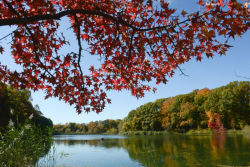Alley Pond Park
The Daily Plant : Wednesday, September 22, 2010
Autumnal Equinox: Parks Foliage Guide

Malcolm Pinckney
The leaves outside of our office windows at The Arsenal are still quite green, and I’ve yet to hear that satisfying crunch that comes when browned, fallen leaves take over the sidewalk, but fall is officially here. According to the National Weather Service, today marks the autumnal equinox. At 11:09 p.m. this evening, the sun will be directly over the earth’s equator and from now into the spring, there will be less than twelve hours of sunlight each day. And this all really means that before too long—and even with eighty-five degree weather in the forecast today—we’ll all have to retrieve our winter coats from the back of the closet.
More optimistically speaking, though, it means that we have a lot of beautiful foliage to look forward to, especially in our parks. As a recent Vermont transplant in this city, I’m used to seeing those postcard scenes outside my front door and rolling my eyes at the “leaf-peepers” who come in from other states, armed with digital cameras and tree reference books (I know, I know: it’s not the same as dealing with Times Square!). With that in mind, and with fall upon us, I did some studying and put together a brief guide to some of the most vibrant foliage spots throughout the five boroughs.
MANHATTAN
Inwood Hill Park is home to the Island’s last remaining natural forest and salt marsh, and there is a wonderful network of trails to follow as you take in the oak-hickory forest. The Natural Resource Group’s Forest Restoration Team worked in the early 2000s to remove the invasive Norway maple trees, which was hampering the native tree growth, and replaced them with Tulip poplar trees, which boast a bright yellow cover in the fall. Almost any vista in Central Park will satisfy a foliage quench, but the Literary Walk, with its canopy of American elm trees, is perhaps the most spacious—and thus the safest to stroll whilst gazing upwards.
STATEN ISLAND
There’s an autumnal marathon to be found in Staten Island: the Greenbelt has about 35 miles of walking trails, and long-standing groves of oak, hickory, beech, maple, sweet-gum, and tulip trees. The summit of High Rock Park is a wonderful place to see the colors from above. Another highlight is the giant, 300 year-old, 107-foot-tall tulip tree in Clove Lakes Park, which holds the title of Staten Island’s largest living thing. Clove Lakes is also home to white pine, maple, beech, and oak trees.
BROOKLYN
Just across the bay, Owl’s Head Park offers a large and diverse collection of trees against the backdrop of the Harbor. There are colorful oaks, maples, beeches, and tulip poplars on the grounds. And, of course, there’s Prospect Park, which is home to over 150 species of trees. It’s easy to spot the ubiquitous black cherry, Norway and Sycamore maple, red oak, and sweet-gum trees, but it’s also possible to track down the rarer cutleaf beech, single leaf ash, and weeping mulberry trees. The Lake adds a beautiful reflected view of the impressive color palette on the water. For additional variety, head to Fort Greene Park to see the massive London Plane trees, as well as oaks, elms, and osange orange trees.
BRONX
Walk the Kazimiroff Trail in Pelham Bay Park to find what the Urban Park Rangers consider some of the best fall foliage the city has to offer. The forest largely consists of oak, hickory, and sweet-gum trees. There is also a 400 year-old white oak tree on the Split Rock Golf Course that may be one of the oldest trees of its kind in the country. Van Cortlandt Park, with over a thousand acres of land, also has a wonderful network of trails to explore and see the changing colors. Check out native oak-hickory forests on the Old Croton Aqueduct Trail, the Putnam Trail, and the John Kieran Trail.
QUEENS
There is a real variety of shifting colors to be found in Forest Park: the grounds have northern red oak, scarlet oak, tulip poplar, shagbark hickory, white oak, and wild black cherry trees. The oak trees will turn a deep red color, and tulip poplar trees a bright yellow. At Alley Pond Park, a native hardwood (oak-hickory) forest has flourished in the past ten years since the Urban Forest and Education Program cleared a spread of invasive vines and shrubs. The Forest Restoration Team planted more than 30,000 trees and shrubs—mostly native oaks and maples—in 1998.
And if you’re still not satisfied, well, there’s always upstate.
“Delicious autumn! My very soul is wedded to it, and if I were a bird I would fly about the earth seeking the successive autumns.”
George Eliot
(1819 - 1880)
Check out your park's Vital Signs
Clean & Safe
Green & Resilient
Empowered & Engaged Users
Share your feedback or learn more about how this park is part of a
Vital Park System










